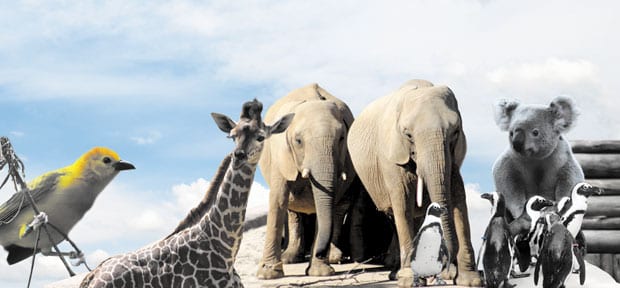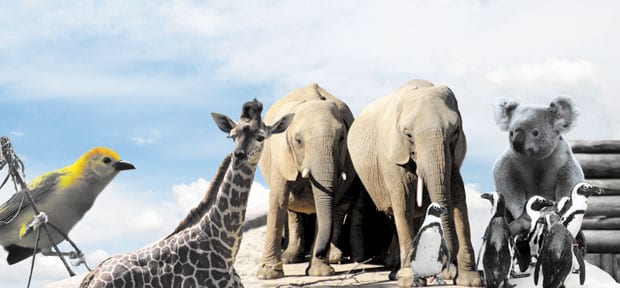Dallas Zoo conservationist, wildlife expert to lead Wyoming and Montana tour

DAVID TAFFET | Senior Staff Writer
Our pets are part of our families, and in the LGBT community we sometimes love our pets more than our families.
And we love wild animals too. We feed birds in our yards and many community members belong to the Dallas Zoo so that they can help make sure those city residents are well cared for, too.
In September, Ben Jones, dean of the Dallas Zoo Wild Earth Academy, will lead a wildlife trip through Montana and Wyoming. Many in the LGBT community met Jones, who was director of the Trinity River Audubon Center, at a large Gay and Lesbian Fund for Dallas fundraiser for the nature center.
The Montana/Wyoming tour, Jones said, is open to anyone. But he believes it will be especially appealing to the animal lovers in the LGBT community.
“The trip will be packed full of some of the most charismatic animals in North American,” Jones said of the eight-day itinerary, which begins near Glacier National Park. The group will be met there by National Geographic and Discovery Channel wildlife producer Rob Whitehair.
Jones said the trip will crisscross the two states. From Glacier, where grizzly bear on mountainsides and black bear in the valleys will be feeding, preparing for hibernation, the group will head down to Yellowstone National Park, where Jones said he hopes the group will be able to see three wild dog species in one day — red fox, grey wolf and coyote.
“Wolves are one of the highlights of Yellowstone,” Jones said.
Reintroduction of the wolves, which had been wiped out in the park, has changed the ecological balance, Jones said. Elk had overpopulated. Now, willow stands the elk overgrazed have returned, providing nesting places for songbirds. Beaver colonies have rebounded along with the willow they needed to flourish, and renewed beaver dams have had an effect on the rivers and fish populations.
Watching a pack of wolves in Yellowstone, Jones said, feels like lightening in your veins.
Two years ago, Jones said, he saw a pack of wolves run through a pride of bison. They stopped and did a chorus howl in a circle. It was, he said, “the call of the wild.”
Other specialists will join the group at different points throughout the trip, including an owl specialist Jones hopes will lead the group to see an elusive snowy owl. Bald eagles are always exciting to see, Jones continued, but Yellowstone is known for an incredible variety of birds — woodpeckers, kingfishers, cuckoos, magpies, jays.
A Blackfoot elder will guide the tour through his reservation in Montana, providing special access to land where wildlife is abundant along roads not generally open to the public.
From Yellowstone, the group will travel along the Beartooth Highway to Billings. The 68-mile-long highway is known for having one of the most diverse ecosystems in the world. Along the way, the group will see 20 peaks that reach higher than 12,000 feet.
Mountain goats, moose, bear mule deer, elk and marmot are plentiful along this route.
From Billings, the group will head back to Dallas.
Jones said the trip was a celebration of the centennial of the national park service, which was chartered on Aug. 26, 1916.
Sept. 10-17. $3,000 per person double occupancy. $550 single supplement. Airfare not included. Reservations email development@dallaszoo.com.
……………………..
Dallas Zoo: What’s best, what’s new, what’s on the way
What’s best
Giants of the Savannah — the habitat that opened in 2010 and is home to elephants, giraffes, impalas, zebras, ostriches, lions, warthogs, red river hogs, guinea fowl and cheetahs — was named third best zoo exhibition in the nation in 2015 by USA Today.
The year before, USA Today named The Dallas Zoo one of the Top 10 zoos in the U.S., finishing one place ahead of the famous San Diego Zoo.
What’s New
A new 3.5-acre, $13.5 million hippopotamus habitat is under construction in the Wilds of Africa area of the zoo.
What’s Newest
Four baby lesser flamingos were born this year at the Dallas Zoo. The greater flamingos are in Zoo North. The lesser (smaller) flamingos are across from the monorail station. Babies are fluffy, down-covered gray. As they eat more shrimp, their new feathers will turn pink.
What’s Coming
Congo, Kamba, Jenny and Gypsy are the four Asian elephants that live in the Giants of the Savannah habitat. All are retired circus elephants in their 30s, past breeding age.
Five elephants recently rescued from drought conditions in southern Africa are in quarantine for another week. Once that period is over, they’ll be gradually introduced as they care to leave their barns and explore their new home.
Zookeepers believe the introduction will be a non-event for the elephants. The animals have been communicating with each other in their low-pitched sounds that are not audible to humans, so each group knows the other is there. They think Congo, Kamba, Jenny and Gypsy already let the new Dallas Zoo arrivals know that they’ll be safe and happy in their new homes.
The new elephants won’t be paraded out. The Dallas Zoo doesn’t coerce animals, and would lose accreditation with the American Zoological Association if it did. Instead, the door will be opened and when the elephants are ready to come out and explore, they will. Zookeepers believe the new arrivals will be curious to meet the others they’ve been talking to.
What’s Renovated
After 25 years of operation, the zoo’s monorail has been rebranded, retrofitted and overhauled. The station’s arrival and departure area has been redesigned, with two aviaries added. The mechanical system was rebuilt with new electrical and the cars outfitted with air conditioning. New species will be added to new environments. That includes the new hippo exhibit that opening spring 2017. The Wilds of Africa
Adventure Safari monorail reopened on March 25.
What’s Only Here
The Giants of the Savannah is the only zoo exhibit in the U.S. that mixes giraffes and elephants in one habitat that also includes zebras, guinea fowl and ostriches. Greater kudu is the newest species being introduced into the environment.
No other zoo has 12-feet-deep pools that allow the elephants to totally immerse themselves, nor does any other zoo give the elephants migration paths. Each day something is changed in their environment to give them new experiences. And each elephant is equipped with a Fitbit ankle bracelet to allow caretakers to track their migration, exercise and other activities.
What’s Cuddly
Dallas Zoo has the only koalas in Texas.
What’s Not So Cuddly
The Dallas Zoo has one of the largest collections of venomous snakes in the U.S., and so it maintains the biggest supply of anti-venom, providing the anti-venom sera to hospitals throughout the Southwest when someone is bitten by a poisonous snake. The $200,000 collection is kept in a small refrigerator and was last delivered by armed police escort.
What’s Endangered
Dallas Zoo’s penguins are an endangered species from the mild southern African coast. A couple gave birth last year to the zoo’s first baby. A newborn is covered in down that would sink them if they tried to swim. After growing his first feathers that keep his skin dry and body streamlined, the baby recently took his first swim.
Dallas Zoo Stats:
• Dallas Zoo is home to about 2,200 specimens from about 430 species (excluding fish and invertibrates).
• Of those, 66 species are managed through the Species Survival Program.
• Dallas Zoo covers 106 acres.
• Dallas Zoo employs 315 full-time staff.
• Dallas Zoo has 16,000 members.
• In 2015, 1 million people visited the Dallas Zoo for the first time. Attendance is currently running ahead of last year.
— Photos by David Taffet
This article appeared in the Dallas Voice print edition April 1, 2016.


